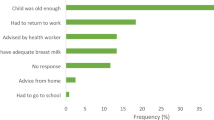Abstract
Objective
To assess the practice of complementary feeding (CF) in infants 6 month to 2 year, knowledge of mothers regarding CF, and reasons for inappropriate CF practices.
Methods
CF practices were assessed in children aged 6 months to 2 years using semi-structured questionnaire. Demographic profile and mother’s knowledge regarding CF was recorded. Cause of inappropriate CF was ascertained by open-ended questions.
Results
Among the 200 children studied, 32(16%) were not started on CF at all, and only 35 (17.5%) received CF from 6 months. Of the 168 who were started CF, mean age of starting feeds was 13.37 months. Quantity was adequate in 42(25%) and consistency of food was thick in 64(38%) cases. Only 7(3.5%) mothers started CF at proper time, in adequate quantity and with proper consistency. Knowledge of proper timing was present in 46% of children, adequate quantity in 46.5% and thick consistency in 25.5%. Only 16(8%) mothers had proper knowledge of all three aspects of CF. Knowledge regarding appropriate timing and consistency varied significantly with maternal education and paternal education (Chisquare P<0.05). On multiple logistic regression only maternal education of graduate level corelated with knowledge of timing of CF (P=0.089. OR-3.5, Cl 0.826–15.2). Most common reason for inappropriate practice in 154 mothers who delayed feeds was “tried but did not eat, vomits everything” (52%).
Conclusion
CF practices were inappropriate and knowledge inadequate in majority of the children studied.
Similar content being viewed by others
References
World Health Organization. The optimal duration of exclusive breast-feeding: report of an expert consultation (WHO/FCH/CAH/01.24). Geneva; March 2001.
World Health Organization. Global forum for child health research: a foundation for improving child health. Switzerland, Geneva, WHO, 2002. www.who.int/child_adolescent_health/New_publications_HEALTH/GC/WHO_CFH_CAH_02.3.PDF [last accessed May 2004].
Gareth J, Stekette RW, Black RE, Bhutta Za, Morris SS. How many child death can we prevent this year? Lancet 2003; 362: 65–71.
Popkin BR, Adair L, Akins JS, Black R, Briscow J, Flieger W. Breast feeding and morbidity. Pediatrics 1990, 86: 874–882.
Simondon KB, Simondon F. Age at introduction of complementary food and physical growth from 2 to 9 months in rural Senegal. Eur J Clin Nutr 1997; 51: 703–707.
Gibson RS, Ferguson EL, Lehrfeld J. Complementary foods for infant feeding in developing countries: their nutrient adequacy and improvement. Eur J Clin Nutr 1998; 52: 764–770.
Bhandari N, Mazumdar S, Bahl R, Mortines J, Black RE, Bhan MK. An educational intervention to promote appropriate complementary feeding practices and physical growth in infants and young children in rural Haryana. J Nutr 2004; 134: 2342–2348.
Sethi V, Kashyap S, Sethi V. Effects of nutritional education of mothers on infant feeding practices. Indian J Pediatr 2003; 70: 463–466.
Vaahtera M, Kulmala T, Hietanen A, Mdekha M, Cullinan T, Salin ML et al. Breast feeding and complementary feeding practices in rural Malawi. Acta Paediatr 2001; 90: 328–332.
Parekh C, Bavdekar SB, Shahrao V. Study of infant ffeding practices: factors associated with faulty feeding. J Trop Pediatr 2004; 50: 306–308.
WHO. Complementary feeding counseling;a training course; May 2002, 10.
Engle PI. Infant feeding styles: Barriers and opportunities for good nutrition in India. Nutr Rev 2002; 60: 109–114.
Kalanda BF, Verhoeff FH, Brabin BJ. Breast and complementary feeding practices in relation to morbidity and growth in Malawian infants. Eur J Clin Nutr 2005; 23: 189–194.
Hendricks K, Briefel R, Novak T, Zieglav P. Maternal and child characteristics associated with infant and toddler feeding practices. J Am Diet Assoc 2006; 106: 135–148.
Amir LH, Cwikel J. Why do women stop breastfeeding? A closer look at ‘not enough milk’ among Israeli women in the Niger Region. Breast Feed Rev 2005; 13: 7–13.
Cohen R, Brown KH, Canahuati J, Rivera LL, Deway KG. Dffects of age of introduction of complementary food on infant breast milk intake, total energy intake, and growth: a randomized intervention study in Honduras. Lancet 1994; 334: 228–293.
Author information
Authors and Affiliations
Corresponding author
Rights and permissions
About this article
Cite this article
Aggarwal, A., Verma, S., Faridi, M.M.A. et al. Complementary feeding —Reasons for inappropriateness in timing, quantity and consistency. Indian J Pediatr 75, 49–53 (2008). https://doi.org/10.1007/s12098-008-0006-9
Received:
Accepted:
Published:
Issue Date:
DOI: https://doi.org/10.1007/s12098-008-0006-9




